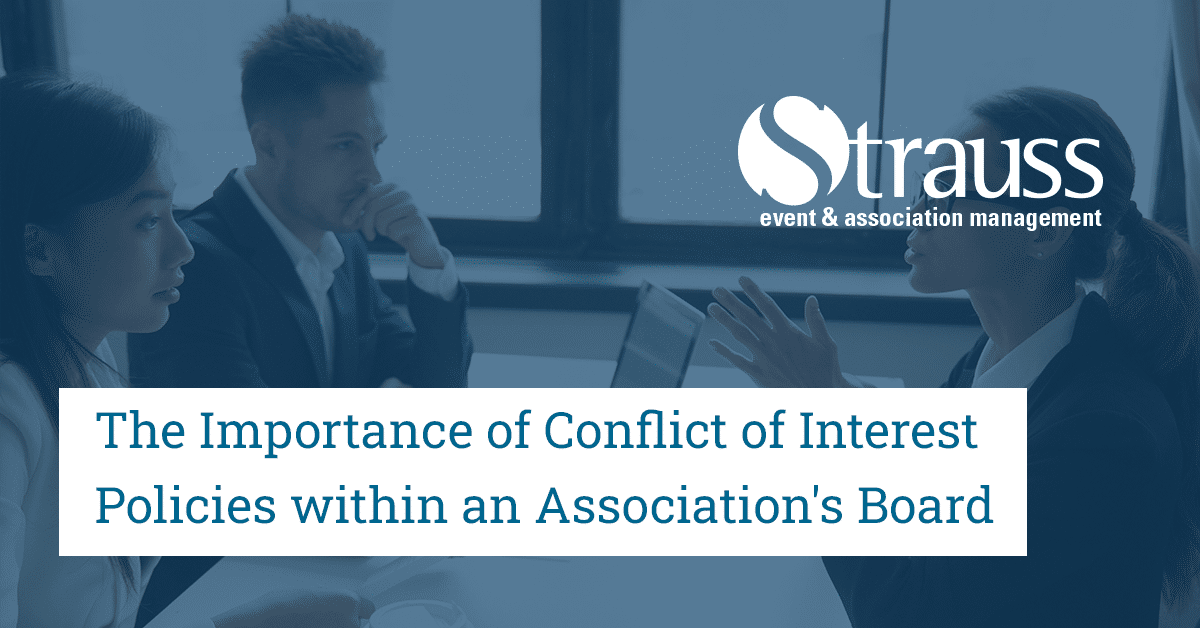Each Board member brings to the Board a special set of skills and life experiences. Volunteering is the lifeblood of not-for-profit associations, and attracting qualified leaders often attracts people that may have conflicts of interest or perceived conflicts of interest with the association they are involved with. So, how do you manage this?
Before we delve into the topic, I want to note I’m not a lawyer. But I am a 24+ year veteran in association management, and these are some of my key learnings when Board members are faced with a possible conflict of interest. Given that boards are often made up of members of a profession or industry, the opportunity for conflict is there. No board is immune from conflicts of interest arising, so it is good for boards to recognize this.
As an association management company (AMC), we manage multiple groups. Many of our clients have conflict of interest policies that Board members sign annually giving them an opportunity to declare any conflicts that might arise from their involvement with the Board of Directors. An example of some language for describing the policy and what it encompasses is as follows:
Each member of the Board of Directors has a duty of loyalty to the association. In furtherance of this duty, it is the policy of the association that directors may not use their position as directors for personal, family, or professional gain. Directors may not obtain for themselves, their relatives, or their friends a financial or material interest of any kind from their connection with the association.
Each director has a duty to give undivided allegiance to the association when making decisions affecting the association and in any transactions, dealings, or situations involving the association. In furtherance of these obligations, the association has adopted a Conflict-of-Interest Policy and Procedures applicable to its directors.
Examples of what is signed can be found online from sites such as boardsource.org, which have sample conflict of interest documents you can adapt to your organization. But the rationale behind creating this policy and having Board members sign a declaration is to help board members understand the “hat” they wear when they arrive at the Board table. Their loyalty is to the association and not their “own” business interests. This can be a stretch for volunteers to wrap their heads around, especially business owners, so reinforcing it with a policy is a good governance practice.
We live in a world that is highly energized and people formulate opinions quickly, especially about what is right and wrong. Having this type of policy in place will protect your board members from scrutiny down the road if a conflict or perceived conflict arises.
Examples of Conflicts of Interest and How to Disclose
An example of a conflict of interest for a Board member may involve a discussion or motion around a particular business they are directly involved in or own. The Board member should immediately disclose they have a conflict of interest and remove themselves from further discussions, motions, or voting.
The disclosure of the conflict of interest should be recorded in the meeting minutes with a note stating the Board member left the room and refrained from voting. This protects the Board and the Board member.
On the flipside of this, one AMC client recently had a scenario where a Board member was part of a company that came out with a controversial practice creating an uproar in the profession. Was the Board member in a conflict with the association by not disclosing the practice that his company was taking part in? Some members suggested that Board member was obliged to declare a conflict as members felt the controversial practice was detrimental to the profession. The Board member did not disclose a conflict with the Board. In actuality, the Board member was not in a conflict of interest and here is why:
- The Board member did not use their position on the Board to advance their business interests and therefore was not required to disclose the controversial practice to the board. All members of the association had the opportunity to utilize the guideline as laid out by the association.
- The Board member was not responsible for creating the guideline, it was a Board decision to create the guideline. The business was working within the confines of the guideline, even though many members felt the controversial practice went against the spirit of the guideline.
The conflict-of-interest policy is in place to protect your Board members and to protect the integrity of your association. If your association is not utilizing a policy that allows your Board members to declare conflicts, I highly recommend you start and implement one.

